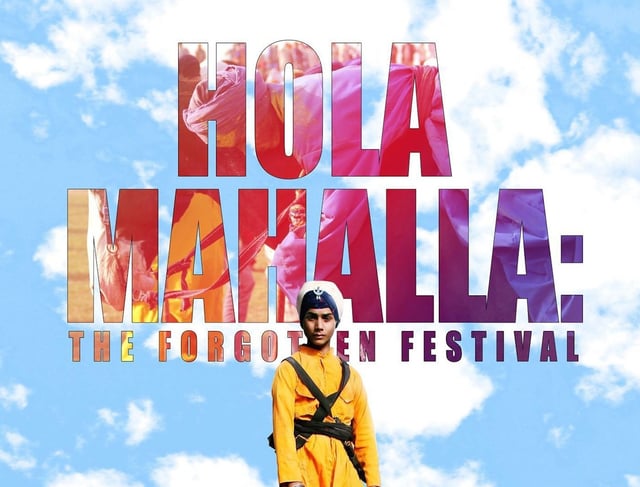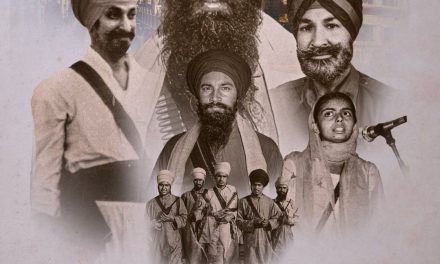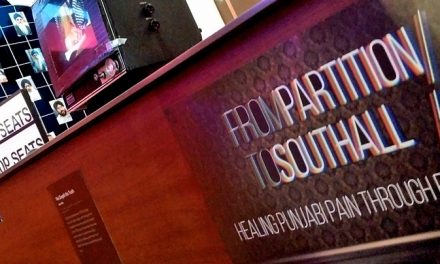‘Hola Mahalla: The forgotten festival’ is a documentary by Darshan Singh of DS Creations. It is depicted as a feature production focusing “on the Sikh festival Hola Mahalla that has been running since the 17th century, showcasing skills such as swordsmanship and daring horse stunts that are with an ever decreasing number of nomadic Sikhs“. I wasn’t sure quite what to expect as there are a number of avenues this documentary could have taken: perhaps an exploration of how and why Hola Mahalla is less well known as a Sikh festival; or a cursory look at the changing world of the nihangs; or maybe this would be an introductory look at the least well-known Sikh festival. It proved to be in essence a little of all these things and more.
Lasting just under 45 minutes, ‘Hola Mahalla‘ is a visual feast of intriguing colours, sights and sounds. The quality of what appears on screen is excellent, particularly when one considers the speed and ferocity with which much of the festivities take place. As I watched, I began to view much of the footage as a valuable resource for the purpose of documenting and archiving how Hola Mahalla is practiced in Punjab today – which is a heady mix of evolved traditions and authentic Sikh culture. There are contributions by Baba Nihal Singh, Jathedar of the Harian-belan based Tarna Dal, and the now deceased Giani Tirlochan Singh who was Jathedar of Takht Kesgarh Sahib at Anandpur, home to the festival of Hola Mahalla. They both articulated the history and purpose of the festival, with the former going into some considerable detail on a range of elements. There’s was a credible voice that complimented the narrative and direction of the documentary, making it a significant work for both students of Sikhi and those wishing to simply learn more.
For a work that was presented over three quarters of an hour, I was expecting more questioning and presentation about the future of the festival, not only in Punjab but in the West too. Although there was reference made to the Vaisakhi Nagar Kirtans of the UK, both visually and verbally, there was no mention of Hola Mahalla-related events that occur here – either in the form of gatka or sports tournaments, or gatherings of a more musical nature (dhadi darbars, katha/kirtan smagams). The production whilst engaging, consists of too much general information about Sikhi from the serving of langar to the origins of the Darbar Sahib at Amritsar. Whilst scene setting is important to documentaries like this – particularly if it makes its way into the education system which this looks perfect for – the voice-over narration style that persisted throughout the documentary made this a sensory overload. It seemed at times that there was just too much information, even if much of it was relevant and perhaps the director fell foul of wanting to cover too many bases, which is a common occurence in topics that haven’t been documented previously to a large extent. Less can truly be more in documentary, and this work would have benefitted from that.
Funded through a Kickstarter project which I contributed to, I was concerned that I would be far too critical of the finished work (and the previous paragraph might suggest so), but in earnest I found this to be a most welcome addition to the documentaries that are now available about the Sikh way of life and its traditions. For a considerably humble budget, DS Creations have produced a work to be proud of that I think would do well for those in the education sector wanting to gain more of an insight into the Sikh martial tradition. That it could be presented at differing levels of institution, from primary schools to University programmes, is a testament to the amazing visuals and the softly-spoken narration. In fact, watching this documentary begs the question to be asked of the three UK-based Sikh TV stations as to just what they are doing with their considerable resources and finances, when those with much less are creating works of this calibre.
The documentary has been screened in Bradford, the home town of the film-maker, and is planned to be shown in London early in August. It is available to purchase and watch both digitally and as a DVD now, directly through the dedicated website, which itself provides the opportunity for the film-maker to share additional resources (certainly a must for the education sector).
In conclusion, ‘Hola Mahalla: The forgotten Festival’ is described by DS Creations as taking “the viewer on a journey through the festival and Anandpur Sahib, the “City of Bliss”, providing a snapshot into a world rarely experienced outside of India and exploring this Forgotten Festival” and in that regard it is a most worthy documentary, worthy of the audience’s consideration.







